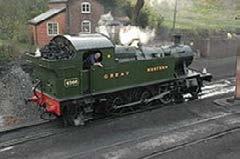
4 minute read
Great Western Railway Power and Weight Classification
A surviving GWR 2884 steam locomotive with a power rating of a black “E” on the blue weight classification disc above the number plate. A white "X" can be seen between the disc and the number plate, which affects how the power class is interpreted. (West Somerset Railway)
Advertisement
Since 1920, the cabins of Great Western Railway (GWR) steam locomotives have been labelled on a coloured disc, allowing staff to quickly assess the capabilities of locomotives without having to check datasheets. The letter designated the power rating, and the coloured disc indicated the weight limit. This system continued even after the GWR became the Western Region of British Railways.
History

A surviving GWR 4500 class steam locomotive with a "C" power rating on a yellow route restriction disc on the upper side of the cab. (Philip Halling)
On July 1, 1905, the Great Western Railway (GWR) introduced a designation system for both transport capabilities and weight restrictions that applied to different classes of locomotives. Initially, this was only used in logbooks, but from mid-1919 it began to appear on the locomotives themselves. The weight limit was shown as a coloured disc, and the power class by a capital letter on the disc. At first it was painted high on the side of the cockpit but, during the Second World War in darkened measures to ensure that personnel had to be careful with the use of light at night, the disc and letter were moved down to a position just above the engine cabside number plate to make them more visible.
When locomotives were loaned to the GWR by other railways during World War II, they were also given a GWR power and weight classification so that GWR locomotive design personnel could select the most suitable engine for the task without having to learn an unfamiliar system.

Two diesel-hydraulic locomotives of the Western region; D7072 (left) is class 35 with a red route restriction disc; D6343 (right) is Class 22 and has a yellow disc. Both discs are numbered on the sides. (Max Battens)
The GWR was nationalized in 1948, becoming the Western Region of British Railways and in 1949, BR decided to adopt the London, Midland and Scottish Railways (LMS) capacity classification system for all locomotives. Despite this, the use of a letter to denote power classification continued to be used on former GWR steam locomotives, as did a coloured disc for weight classification; both continued until the end of steam traction on the Western Region in 1965. Certain ex-LMS and BR Standard steam locomotives dedicated to the Western Region were provided with GWR type route classification discs, usually without
Table 1 Power classification
The letter represents the power of the locomotive and is approximately proportional to the starting tractive effort, thus:
Power class Pulling force Examples of classes
GWR/BR of locomotives
Special Over 38,000 lbf (169.0 kN) 6000 (King)
E 33,001-38,000 lb (146.8-169.0 kN) 2884, 7200
D 25,001-33,000 lb (111.2-146.8 kN) 4073 (Lock), 4300, 5600
C 20,501-25,000 lb (91.2-111.2 kN) 4500, 5700
B 18,501-20,500 lb (82.3-91.2 kN) 1101, 2251
A 16,500-18,500 lb (73.4-82.3 kN) 1600, 2301 Ungrouped Less than 16,500 lb (73.4 kN) 1361, 1400
The "Special" classification was not shown in the "King" class, but in the case where it was not, e.g. 111 Great Bear, "Special" was marked with an X (+) on the red route restriction disc.
a power class letter. Some of them were of the power class BR, shown on the disk in the form of a picture, e.g. class 5 4-6-0had the number "5" on the red disc. A coloured disc was also applied to some diesel locomotives delivered to the Western Region. (see Table 1 above)
Locomotives leased during World War II were assigned GWR power class letters to avoid confusion with the various systems used by the credit railways. For example, the Southern Railway (SR) also used letters, but with the letter A representing the highest degree; so when SR lent GWR a few S15s of 4-6-0 class that were power class A on SR, GWR placed them in power class D; likewise, London, Midland and Scottish Railways leased 2-80 locomotives in their 8F power class, which were assigned GWR E power class.

6833 Calcot Grange. The locomotive class ex-GWR 6800 (Grange) with a white «X» under the red disk limitation route, indicating that the normal load may be exceeded for its power class (D).
It was also decided during World War II that certain classes of two-cylinder engines (including classes 1000 (County), 4900 (Hall) and 6800 (Grange )) would be allowed to carry loads heavier than those indicated in the workbooks. for their power classification. These engines were distinguished by a white "X" painted above the license plate.
Weight limit
The GWR system was divided into “red”, “blue”, “yellow” and “unpainted” routes according to the maximum axle load allowed by the civil engineer: for example, engines with an axle load of more than 16 tons were not allowed on "yellow" or "unpainted" routes. Between them were "red dots" and "blue dots", which allowed the use of overweight engines subject to speed limits. In addition, there were “shaded red” routes where any locomotive was allowed: class 6000 (King) was prohibited for all but the “shaded red” routes. In August 1938, a summary of GWR routes by colour was published (See Table 2 opposite)
Preserved steam locomotive Class GWR 6000 (King) with double red disk, painted on the cab side, indicating the most severe weight classification; power class (Special) not specified (Chris McKenna)











